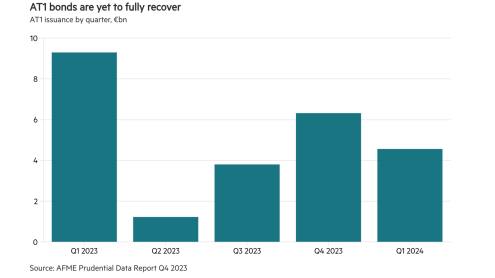Overall, foreign banks have exposure of $121.47bn in Russia, comprising $67bn of international claims and $54bn of local claims, according to statistics from the Bank for International Settlements at the end of September 2021. Claims are defined as all types of lending, such as loans and bonds, to all borrowers physically located in Russia.
Banks from Italy and France are most exposed to Russia, together accounting for just under a half of the total exposure of foreign banks in Russia, at $25.3bn and $25.2bn, respectively. This is followed by Austrian banks at $17.5bn, US banks at $15.7bn and Japanese at $9.6bn.
The big exposures from Italy and France stem from Société Générale (SocGen) and UniCredit.
As of the end of 2021, SocGen had a total exposure of €18.6bn to Russia, or 1.7% of the bank, of which €15.4bn is accounted for at its Russian subsidiary, Rosbank. In 2021, activities in Russia generated 2.8% of SocGen’s net banking income.
SocGen estimates a capital impact of around -50 basis points to its common equity Tier 1 (CET1) ratio should the bank be stripped of property rights to its banking assets in Russia. The bank’s CET1 ratio stood at 13.7% at the end of 2021.
Meanwhie, UniCredit’s Russian subsidiary has a self-funded loan position of €7.8bn and the bank's net cross-border exposure to Russian companies stands at €4.5bn.
UniCredit expects an impact of around 200 basis points to its 2021 year-end CET1 ratio of 15.03% in an extreme scenario where the entire maximum exposure to Russia is non-recoverable.
“The local Russian exposures are small relative to the parent groups, accounting for less than 2% of total exposures in each case,” Fitch Ratings said in a statement. “Even a full write-off of the two banks’ investments in their Russian subsidiaries in an extreme scenario would have a fairly moderate impact on capital at a group level.”
Other banks with significant exposures to Russia include Austria’s Raiffeisen Bank International (RBI) and Hungary’s OTP Bank.
RBI’s subsidiaries in Russia and Ukraine contributed 42% of the group’s 2021 profits, with just under 35% of its total net profit coming from its Russia operations, according to Moody’s. Meanwhile, OTP Bank’s Russian and Ukrainian operations amounted to around 14% of the group’s profits for the nine months to September 2021, with just over 5% coming from Russia.
“The parent banks will be faced with weakening asset quality and rising loan-loss provisioning needs, reducing the profitability of their subsidiaries,” Moody’s said in a statement. “Difficulties will be exacerbated by the lower exchange rates used to convert the net profit into the groups’ domestic currencies. There is also a real possibility, given restrictions on capital flows, together with political and other stakeholder pressure, that these banks have to write down their investments in the region entirely.”











